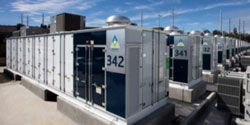Reducing the Risk of Battery Thermal Runaway
One solution to reducing the risk of a battery fire are infrared cameras. Infrared fire detection systems monitor large areas and are able to detect heat releasing from battery packs or single batteries.
The Importance of Infrared Fire Detection Systems for EV Battery Fires
In this article, we will delve into how companies can mitigate the risks associated with EV battery fires by incorporating advanced infrared fire detection systems, such as those provided by MoviTHERM.
Rooftop Solar's Unspoken Truth: Fires and Safety Risks are Uncomfortably Common
Due to inconsistent installation practices, intense manufacturer competition, and sometimes conflicting motives between Operations and Maintenance (O&M) providers and end-owners, the risk of fires looming on rooftop installations is uncomfortably common.
Utility Technology Already Exists for Preventing Wildfires
By deploying a series of low-cost sensors on poles, wires, and more, the company can track parts of the grid that might be at risk for failure. This can help prevent the sorts of catastrophic accidents that could cause devastating wildfires.
Understanding Wind Turbine Fire Protection
A whopping 90% or more of wind turbine fires originate in the nacelle. The nacelle contains the gear box, the generator, the controller, the low- and high-speed shafts, and the brake-and it (the nacelle) sits atop the tower.
What You Need to Know About Energy Storage System Fire Protection
When dealing with any form of energy and its storage, there is always some degree of risk with an associated hazard involved. With PSH, there is a risk that the containment could fail producing the hazard of cascading water rushing through the surrounding area.
Records 1 to 6 of 6
Featured Product

Canadian Solar - HiKuBlack - Black Backsheet & Frame (Mono)
Aesthetic appearance for residential systems: With black backsheet & black frame, Power range 380 ~ 405 W, Low power loss in cell connection. Enhanced reliability: · Low temperature coefficient (Pmax): -0.34 % / °C, LID LeTID less than 2.0%, Lower hot spot temperature, Better shading tolerance.




.jpg)

